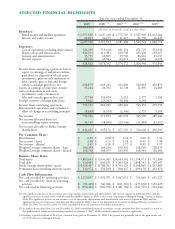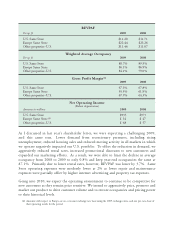Public Storage 2009 Annual Report Download - page 11
Download and view the complete annual report
Please find page 11 of the 2009 Public Storage annual report below. You can navigate through the pages in the report by either clicking on the pages listed below, or by using the keyword search tool below to find specific information within the annual report.We are in a wonderful business with excellent economies, established on a rock-solid financial
structure. What is even more impressive is these returns were accomplished with low leverage
and abundant liquidity. Public Storage and PSB operated at about half the industry average
leverage. A combination of exceptional financial engineering by our talented CFO, John Reyes,
and operational excellence, enabled us to produce results far above the real estate industry.
For most of the decade, the wind was at our back (ours and the commercial real estate
industry). Between 2000 and 2007, conditions could not have been better for owners of
commercial real estate in the United States:
• A relatively low unemployment rate (generally between 4% and 6%) provided a pool of
consumers with stable incomes.
• Previously unimagined low interest rates (ten-year U.S. Treasuries generally at
4%-5%) contributed to lower capitalization rates(7) and promoted home ownership. As
more households became homeowners, they had more “stuff” that needed to be stored
and moving activity accelerated.
• Increases in home prices (peaking in the summer of 2006) created more buying power
to acquire “stuff” to store.
The level of commercial debt doubled between 2000 and 2007, reflecting the high demand
for commercial real estate and the availability of low interest rate loans. Commercial
Mortgage Backed Securities (CMBS) issuance accelerated each successive year, with
issuance peaking at $230 billion in 2007. Total outstanding CMBS debt exceeded
$800 billion at year-end 2007, up from $200 billion in 2000. This coincided with the
peaking of commercial property values. In early 2007, Public Storage common stock
traded about $110 per share at the same time that Blackstone Real Estate Partners (a large
private equity firm) was purchasing Equity Office Properties (then the largest REIT in the
U.S.) for $30 billion. This transaction marked a climax in valuation, as operating
fundamentals and the capital markets quickly began to change.
If you were really smart–you would have sold! But like Cinderella at the ball, most
planned to leave (sell) just before the clock struck midnight. It is very hard to “stop
dancing” when everyone is having such a good time. The last two years have brought an
end to the festivities and, as Warren Buffett says, “The hangover is proportional to the
binge.” Where are we today?
Current Operating Environment
As the U.S. economy slipped into a recession, the reported unemployment rate rose rapidly
from 6% to 10%. If you include the “shadow” unemployment, the “underemployed rate”
is closer to 20%.
(7) Capitalization rate (cap rate) is the ratio between the net operating income produced by the asset and its capital cost or
alternately its current market value.
























